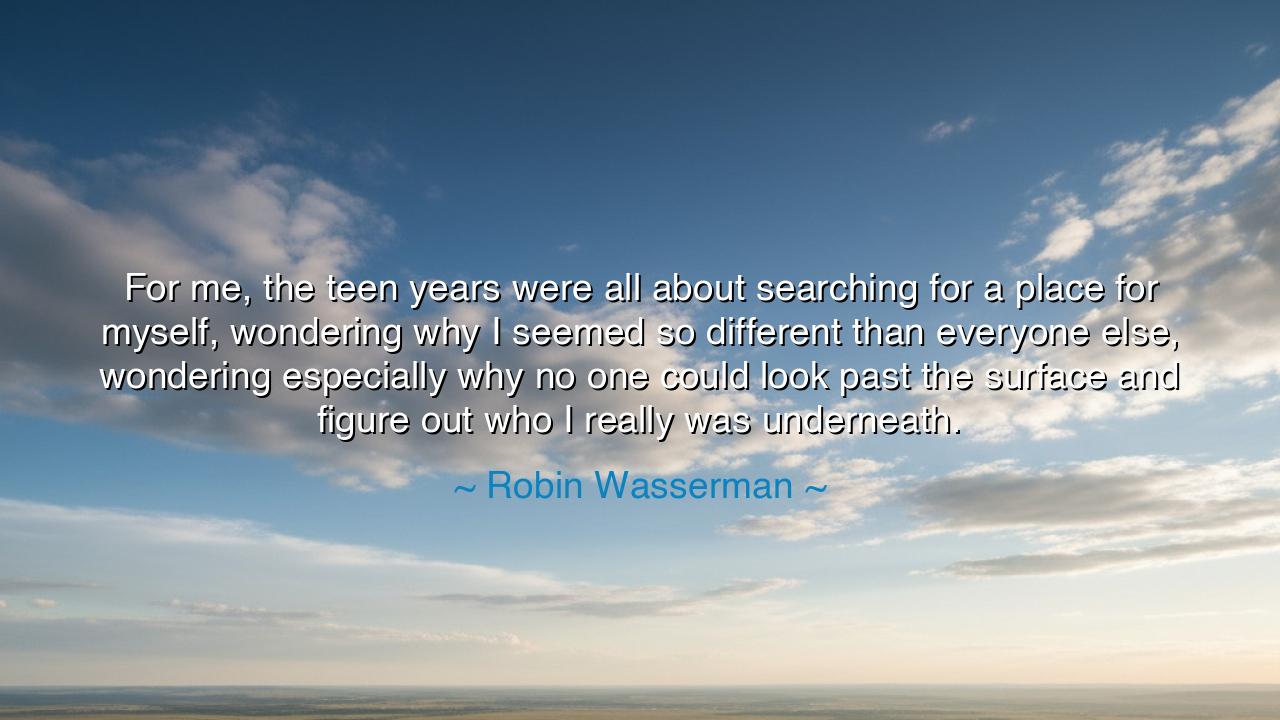
For me, the teen years were all about searching for a place for
For me, the teen years were all about searching for a place for myself, wondering why I seemed so different than everyone else, wondering especially why no one could look past the surface and figure out who I really was underneath.






Robin Wasserman, with honesty born of her own youth, declared: “For me, the teen years were all about searching for a place for myself, wondering why I seemed so different than everyone else, wondering especially why no one could look past the surface and figure out who I really was underneath.” These words carry the raw ache of adolescence, that restless season when the soul longs to be seen, understood, and accepted. Her reflection is not only her own—it is the cry of countless young hearts who feel estranged from the world around them.
The origin of this truth lies in the universal struggle for identity. The teen years are a time of masks and mirrors. One sees the polished surfaces others present, yet inside carries doubts, contradictions, and questions no one seems to notice. Wasserman speaks of the loneliness of feeling different, of wondering why others cannot pierce through to the self hidden beneath appearances. It is a timeless struggle: the yearning for recognition, not for what we seem to be, but for who we truly are.
The ancients knew this journey well. In the myths of Greece, Narcissus gazed upon his reflection and could not look beyond the surface. Yet the deeper wisdom lies not in his vanity, but in the reminder that the surface deceives. True vision is the ability to look past outward form and perceive the essence beneath. Wasserman’s lament is that too few possess such vision—too few can look into the eyes of another and see the soul burning within.
History offers us the tale of Vincent van Gogh, who wandered through life misunderstood, his brilliance hidden from the eyes of those around him. The world saw only his poverty, his instability, his difference. Few could see the luminous genius within, the heart that painted fields of light and skies of fire. Like Wasserman’s cry, his life reminds us how many souls long to be understood beneath the surface, how many suffer in silence because the world’s gaze is shallow.
From this reflection arises a profound lesson: that every soul we meet carries a hidden depth, a story untold, a truth unseen. To dismiss another by appearances is to walk past treasure buried beneath the earth. The task of wisdom is to look deeper, to pierce the veil of surfaces, and to recognize the sacred individuality of each person. To do so is not only to honor them, but to remind ourselves that we, too, are more than what the world sees.
Practical wisdom flows easily: if you are young and feel unseen, know that this struggle is part of the journey, not the end of it. Time will reveal those who can look deeper, who can honor your truth. If you are older, be mindful of those around you—look past the clothing, the silence, the performance, and ask with compassion, “Who are you beneath?” Such a question can be the key that unlocks another’s hidden strength.
So, children of tomorrow, remember Wasserman’s words. The search for place and identity is a noble journey, though it may feel lonely. Do not despair when others fail to see you fully; instead, continue to seek, to build, to reveal your true self. And in your dealings with others, be the one who looks beyond the surface, who listens not only to words but to the silent cry of the soul. For in this way, the loneliness of youth is softened, and the bonds of true understanding are woven across generations.






AAdministratorAdministrator
Welcome, honored guests. Please leave a comment, we will respond soon